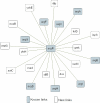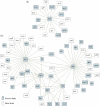Nebulon: a system for the inference of functional relationships of gene products from the rearrangement of predicted operons
- PMID: 15867197
- PMCID: PMC1088069
- DOI: 10.1093/nar/gki545
Nebulon: a system for the inference of functional relationships of gene products from the rearrangement of predicted operons
Abstract
Since operons are unstable across Prokaryotes, it has been suggested that perhaps they re-combine in a conservative manner. Thus, genes belonging to a given operon in one genome might re-associate in other genomes revealing functional relationships among gene products. We developed a system to build networks of functional relationships of gene products based on their organization into operons in any available genome. The operon predictions are based on inter-genic distances. Our system can use different kinds of thresholds to accept a functional relationship, either related to the prediction of operons, or to the number of non-redundant genomes that support the associations. We also work by shells, meaning that we decide on the number of linking iterations to allow for the complementation of related gene sets. The method shows high reliability benchmarked against knowledge-bases of functional interactions. We also illustrate the use of Nebulon in finding new members of regulons, and of other functional groups of genes. Operon rearrangements produce thousands of high-quality new interactions per prokaryotic genome, and thousands of confirmations per genome to other predictions, making it another important tool for the inference of functional interactions from genomic context.
Figures







References
-
- Tatusov R.L., Koonin E.V., Lipman D.J. A genomic perspective on protein families. Science. 1997;278:631–637. - PubMed
-
- Gaasterland T., Ragan M.A. Microbial genescapes: phyletic and functional patterns of ORF distribution among prokaryotes. Microb. Comp. Genomics. 1998;3:199–217. - PubMed
-
- Dandekar T., Snel B., Huynen M., Bork P. Conservation of gene order: a fingerprint of proteins that physically interact. Trends Biochem. Sci. 1998;23:324–328. - PubMed

